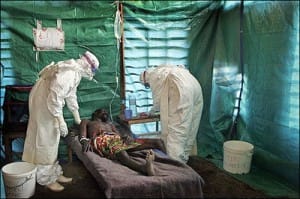The illness was declared an international health emergency by the World Health Organization on Friday and authorities voiced fears the virus could spread worldwide.The country has “put in operation the most advanced surveillance and tracking systems” for the hemorrhagic virus” said India’s Health Minister Harsh Vardhan said in a statement.”There is no need to panic,” he said, calling risk of Ebola cases in India “low”.
There are some 4,700 Indians in Guinea, Liberia and Sierra Leone, the three countries worst hit by the disease, while another 40,000 live in Nigeria, which has also declared a state of emergency because of Ebola.The government is setting up centres at airports and ports to deal with travellers showing any potential symptoms of Ebola, spread through close contact with bodily fluids of people who who are sick.
All air passengers arriving in India from Ebola-affected countries must now fill in a symptom-checklist form and provide addresses as the government builds a database to track people who might develop symptoms.

Source: Business Standard
Key facts About the Ebola Virus Disease (EVD)
- EVD formerly known as Ebola haemorrhagic fever, is a severe, often fatal illness in humans
- EVD outbreaks have a case fatality rate of up to 90%
- EVD outbreaks occur primarily in remote villages in Central and West Africa, near tropical rainforests
- The virus is transmitted to people from wild animals and spreads in the human population through human-to-human transmission
- Fruit bats of the Pteropodidae family are considered to be the natural host of the Ebola virus
- Severely ill patients require intensive supportive care. No licensed specific treatment or vaccine is available for use in people or animals although several experimental ones are being studied. Two American patients have returned to the US from West Africa and are rumoured to have responded well to one of these treatments
Ebola Virus Patient Zero Identified as a Two-Year-Old Boy
Researchers working on tracing the Ebola virus back to patient zero in the current outbreak think that they have identified him, a two-year-old boy who died on December 6, 2013. The toddler fell ill while in a village in southeastern Guinea called Guéckédou. This small village is like a three nation intersection, as it sits on the border of Guinea, Sierra Leone and Liberia. All three of these places have been heavily affected by the Ebola virus outbreak. Scientists think that because the disease started in Guéckédou, it had an easy entry path into the three nations in West Africa that have suffered so many deaths between them. There have now been 1,779 cases of Ebola reported and 961 people have died from the deadly disease.
The week following the death of the two-year-old, the boy’s mother died, and shortly afterwards so did his grandmother. It was not recognized as Ebola virus at the time, but because the boy and the other members of his family had vomiting, diarrhea and fever, scientists believe the deadly virus started here, and that the toddler was patient zero. It is currently unknown how he might have contracted the disease.
According to the Guardian, the outbreak is currently considered to be out of control and getting worse. Health officials believe that the death toll will be higher than that of all other previous Ebola outbreaks combined. The World Health Organization has said that they need thousands more health workers in order to effectively fight the disease and stop it spreading further.80 health workers have already died from the Ebola virus as they have attempted to help others, 145 have been infected. Most consider that the situation will take months to be brought under control. Health officials are also concerned that due to the amount of resources that will be focused on fighting Ebola, deaths from other diseases such as malaria will rise.


